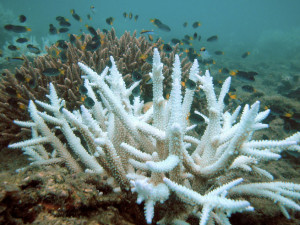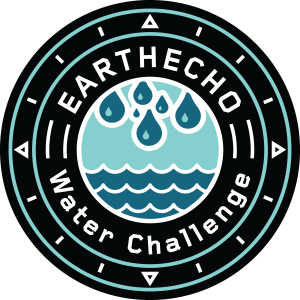By Delaney Reynolds, SRC intern
Coral reefs are some of planet earth’s most spectacular, diverse and important ecosystems. Our planet’s coral reefs provide important shelter, habitats, and a source of food for many different species of marine organisms. They also act as a critical food source to humans, as well a natural barrier to help protect our coastlines from hurricanes and associated storm surges. Sadly, coral reefs face growing risks including the possibility of extinction from a variety of stresses that leads to coral bleaching.
Figure 1: Coral from which the zooxanthellae has been expelled, causing it to turn white (Image Source: http://en.wikipedia.org/wiki/File:Keppelbleaching.jpg)
Coral bleaching is the process in which zooxanthellae, algae living symbiotically within the coral, are expelled from coral colonies due to a number of factors including an increase in temperature, decrease in pH, exposure to UV radiation, reduced salinity, and bacterial infections. Zooxanthellae provide the coral 30% of its nitrogen and 91% of its carbon needs to the coral host in exchange for a shelter, as well as waste produced by the coral from nitrogen, phosphorus, and carbon dioxide that is required for the algae’s growth (Baird, 2002).
When corals bleach, it effects entire marine communities due to their immense diversity. Fish populations that reside around coral reefs “are the most species dense vertebrate communities on earth, contributing critical ecosystem functions and providing crucial ecosystem services to human societies in tropical countries” (Graham, 2008). Researchers have found that when an ecosystem endures physical coral loss, fish species richness is extremely likely to decline due to their heavy reliance on the coral colony itself (Graham, 2008).
Perhaps the most famous current example of coral bleaching is Australia’s Great Barrier Reef. Scientists have determined that the main cause of Great Barrier Reef coral bleaching is induced thermal stress and that about 90% of the reef has been bleached since 1998 (Baird, 2002). As the corals bleach and temperatures increase, researchers have determined that shark and ray species that live in the area may be vulnerable to these climactic changes.
Figure 2: Exposure of Ecological Groups of GBR Sharks and Rays to Climate Change Factors. This figure displays the vulnerability different elasmobranch species face due to climate change, as well as the specific effects of climate change that they are vulnerable to, in the specific zones of the Great Barrier Reef. (Image Source: Chin et al. 2010)
Most of the Great Barrier Reef is located on the mid-shelf of the ocean floor, the approximate mid-point between the shallower coast of Australia and the continental shelf where the ocean bottom significantly drops in depth. Researchers found that the mid-shelf is the area where most of the shark species studied reside, while most rays dwell in coastal waters or closer to the continental shelf. It was also found that both areas are the susceptible to rising temperature, increased storm frequency and intensity, increasing acidity, current alterations, and freshwater runoff, all being caused by climate change (Chin, 2010). Based on these findings, researchers have concluded that the areas these elasmobranchs live in should be protected and preserved. Species in these highly vulnerable areas should also be monitored and considered for future conservation actions, as many of the shark species are already experiencing the effects of climate change from some of the aforementioned factors.
Typically, sharks are considered some of the strongest animals on earth, and while they have lived on earth for at least 420 million years, they are slow to adapt. This slowness has impeded their ability to survive in our rapidly changing climate. In the near future it will be common to see some species of marine organisms demonstrate plasticity, the ability to adapt to their changing environment, but other species, such as elasmobranchs, are expected to simply distribute to other habitats in search of cooler waters. Even though sharks are a highly vulnerable species to climate change, they sit at the top of the trophic level in many different niches and, thus, wherever they migrate to, it will be easier for them to find food than it would be for other species such as fish or rays. However, this is most likely only the case for adult sharks as embryos and juvenile sharks may be more vulnerable to increased temperatures. For instance, researchers found that the survival of bamboo shark embryos decreased from 100% at current temperatures to 80% under future ocean temperature scenarios and that the embryonic period was also shortened, not allowing the embryo enough time to develop fully (Rosa, 2014).
To decrease the effects of climate change on coral bleaching, corrective and mitigation measures can be taken. By utilizing green energy sources such as implementing solar power or wind power, walking or biking, and driving electric cars, we can reduce our use of fossil fuels and carbon footprint, thus decreasing the amount of carbon dioxide polluting and warming our atmosphere and oceans. While underwater and not always visible, coral reefs are truly a vital part of our ecosystem and need to be cherished and protected for generations to come.
References
Baird, A. H., & Marshall, P. A. (2002, July 18). Mortality, growth and reproduction in scleractinian corals following bleaching on the Great Barrier Reef. Retrieved from https://researchonline.jcu.edu.au/1521/1/Baird_and_Marshall_2002.pdf
Chin, A., Kyne, P. M., Walker, T. I. and McAuley, R. B. (2010), An integrated risk assessment for climate change: analyzing the vulnerability of sharks and rays on Australia’s Great Barrier Reef. Global Change Biology, 16: 1936–1953. doi:10.1111/j.1365-2486.2009.02128.x
Graham, N. A., McClanahan, T. R., MacNeil, M. A., Wilson, S. K., Polunin, N. V., Jennings, S., . . . Sheppard, C. R. (2008, August 27). Climate Warming, Marine Protected Areas and the Ocean-Scale Integrity of Coral Reef Ecosystems. Retrieved from http://journals.plos.org/plosone/article?id=10.1371%2Fjournal.pone.0003039
Rosa, R., Baptista, M., Lopes, V. M., Pegado, M. R., Paula, J. R., Trubenbach, K., . . . Repolho, T. (2014, August 13). Early-life exposure to climate change impairs tropical shark survival. Retrieved November 2, 2017, from http://rspb.royalsocietypublishing.org/content/royprsb/281/1793/20141738.full.pdf




